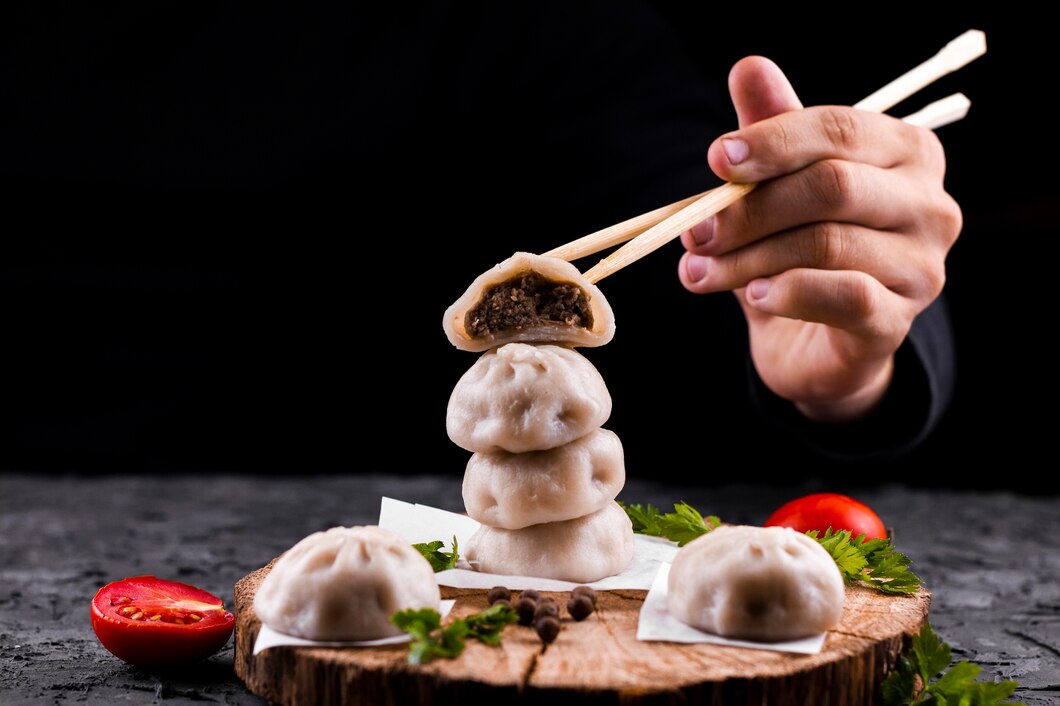Dumplings: they come in all shapes, sizes, and flavors, and they hold a special place in cuisines around the world. From savory fillings to delicate wrappers, dumplings are a versatile and beloved food. We decided to embark on a culinary adventure to explore the unique dumpling varieties from five different cultures. Each dumpling tells a story of tradition, technique, and the love for delicious food. So, which one came out on top? Let’s dive into our dumpling journey and find out!
1. Chinese Dumplings (Jiaozi)
What they are:
Jiaozi, or Chinese dumplings, are an iconic dish in Chinese cuisine, often enjoyed during the Lunar New Year. These dumplings are typically made with a thin, chewy dough filled with ground pork, cabbage, ginger, garlic, and sometimes shrimp. They can be steamed, boiled, or pan-fried, and they’re usually served with a dipping sauce made from soy sauce, vinegar, and chili oil.
Why we loved them:
The combination of the crispy bottom (from pan-frying) and the tender filling made these dumplings a textural delight. The savory pork and cabbage filling was well-balanced, with the perfect blend of spices. The dipping sauce added a delightful tangy kick, making every bite memorable. Chinese dumplings are versatile, and you can experiment with different fillings like beef, chicken, or vegetarian options.
2. Japanese Dumplings (Gyoza)
What they are:
Gyoza are Japanese dumplings closely related to their Chinese cousins, Jiaozi. These dumplings are typically filled with ground pork, cabbage, garlic, and ginger, with a hint of soy sauce for seasoning. The unique thing about gyoza is the way they are cooked—usually pan-fried on one side to give them a crispy texture and then steamed to finish cooking. They’re often served with a soy-based dipping sauce, sometimes with a little vinegar or sesame oil.
Why we loved them:
The crispy bottom of gyoza was absolutely irresistible, offering a perfect contrast to the soft, juicy filling. The garlic and ginger provided a refreshing zing, and the pork filling was juicy and flavorful. What set gyoza apart was the balance of textures—crispy on the bottom, tender on top, with a flavorful interior. The dipping sauce was simple but elevated the taste with just the right amount of saltiness and tang.
3. Polish Dumplings (Pierogi)
What they are:
Pierogi are a traditional Polish dumpling made from a thick dough and filled with a variety of ingredients. The most common fillings include mashed potatoes, cheese, mushrooms, or ground meat, but sweet variations with fruit fillings are also popular. Pierogi are typically boiled, then fried in butter to give them a golden, crispy finish. They are often served with a dollop of sour cream or sautéed onions.
Why we loved them:
Pierogi’s hearty fillings made them feel like a comfort food classic. The rich potato and cheese filling was especially satisfying, with its creamy texture and buttery flavor. The dough was thick but soft, and when fried in butter, it became deliciously crispy on the outside. Pierogi’s satisfying, filling nature made it a great dish to enjoy on a chilly evening, and the sour cream paired wonderfully with the richness of the dumplings.
4. Korean Dumplings (Mandu)
What they are:
Mandu are traditional Korean dumplings that come with a variety of fillings, including ground pork, beef, tofu, kimchi, and vegetables. The dough is similar to that of gyoza or jiaozi but thicker and softer. Mandu can be steamed, boiled, or fried, and they’re often served with a soy-based dipping sauce or in a soup.
Why we loved them:
Mandu had a delightful flavor that was both savory and slightly spicy, especially when kimchi was used in the filling. The fillings were more complex compared to other dumplings, with the inclusion of ingredients like garlic, sesame oil, and soy sauce. When fried, they developed a crispy exterior, and the inside remained juicy and tender. The unique addition of kimchi gave them a spicy kick that made them stand out.
5. Nepalese Dumplings (Momo)
What they are:
Momo is a type of dumpling popular in Nepal, Tibet, and parts of India. The filling typically consists of ground meat (usually chicken or beef), vegetables, garlic, ginger, and spices like cumin and coriander. Momos can be steamed or fried, and they are often served with a spicy dipping sauce made from tomato, chili, and garlic.
Why we loved them:
Momos were a revelation, particularly because of the flavorful and aromatic spices used in the filling. The meat was seasoned to perfection with cumin and coriander, which gave it a rich, fragrant taste. The dough was soft and chewy, and the dumplings were perfectly steamed to retain their juiciness. The spicy dipping sauce, with its deep tomato flavor and chili kick, complemented the momos perfectly.
The Verdict: Which Dumpling Was the Best?
After sampling dumplings from five diverse cultures, it’s safe to say each one offered something unique and special. But if we had to pick a winner, it would be a tough call.
- Chinese Dumplings (Jiaozi) won our hearts for their versatility and the satisfying combination of crispy and tender textures. The balance of flavors and the variety of fillings made them a clear favorite.
- Polish Pierogi earned a spot for their heartiness and comforting flavors, perfect for a filling meal that’s rich and satisfying.
- Japanese Gyoza stood out for their beautifully crispy bottom and balanced filling, with a hint of tang from the dipping sauce.
- Korean Mandu impressed with their unique blend of flavors, especially the inclusion of kimchi for an extra punch.
- Nepalese Momos stole the show with their aromatic spices, juicy filling, and the deliciously spicy dipping sauce.
Ultimately, the Chinese Jiaozi and Polish Pierogi were our top picks, but it’s clear that each dumpling brought its own flair to the table. So, what’s your favorite dumpling? We encourage you to try making all five and decide for yourself!








